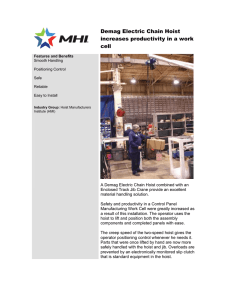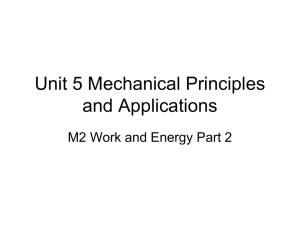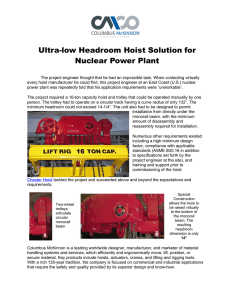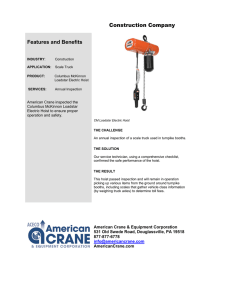Safe Use of Material Hoist - Interlocking Device on Hoistway Gate
advertisement
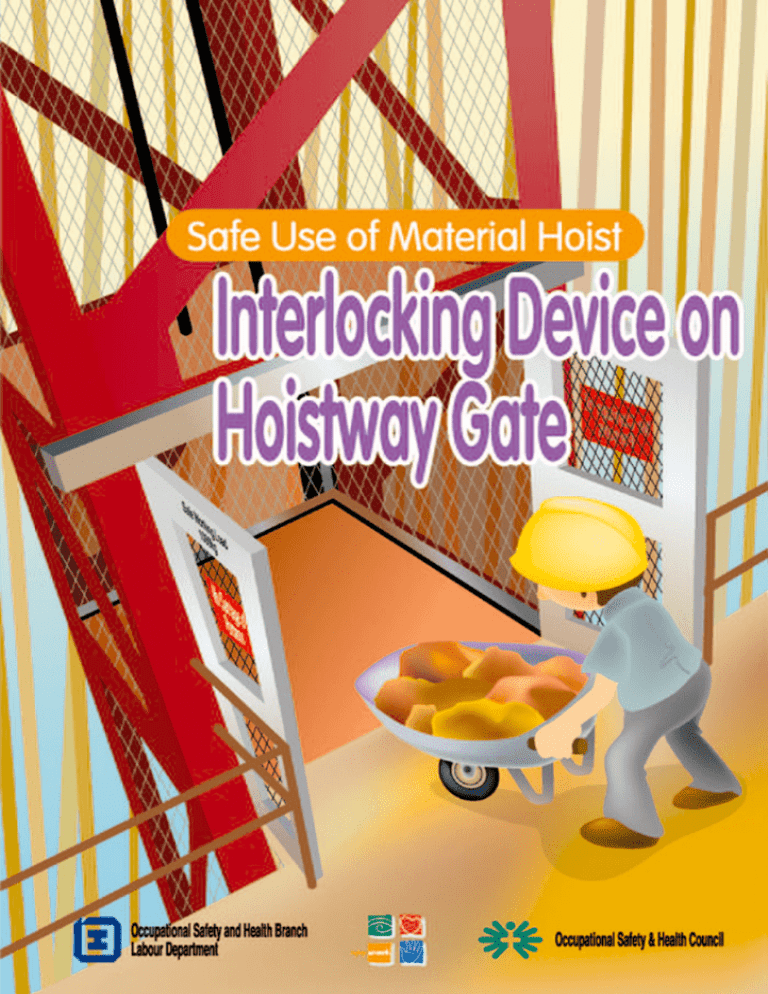
This guide is prepared by the Occupational Safety and Health Branch, Labour Department This edition====March 2004 This guide is issued free of charge and can be obtained from offices of the Occupational Safety and Health Branch, Labour Department. It can also be downloaded from website of the Labour Department at http://www.labour. gov.hk/eng/public/content2_8.htm. Addresses and telephone numbers of the offices can be found in website of the Department at http://www.labour.gov. hk/eng/tele/osh.htm. This guide may be freely reproduced except for advertising, endorsement or commercial purposes. Please acknowledge the source as“Safe Use of Material Hoist - Interlocking Devise on Hoistway Gate”, published by the Labour Department. Safe Use of Material Hoist Interlocking Device on Hoistway Gate Introduction Introduction Material hoist is a plant commonly used on construction sites for material transportation. In the past few years, serious accidents did occur during the use of material hoists. The common scenario of the cases was that the platform/skip of a hoist suddenly moved while loading or unloading was in progress. That caused the worker using the hoist to fall into the hoistway arising from loss of body balance at an unfenced edge, or being trapped by the moving part of the hoist. This pamphlet outlines the control measures in relation to landing gates of material hoists. All users and operators should be familiar with other safety requirements associated with the safe use of a material hoist. N Statutory Requirements Regulation 31(1)(b) of the Construction Sites (Safety) Regulations, Chapter 59I, stipulates that a material hoist shall not be used unless the enclosure is, where access to and egress from the hoist is required, fitted with secure gates. Regulation 31(1)(d) of the Construction Sites (Safety) Regulations, Chapter 59I, stipulates that a material hoist shall not be used unless the gates are kept closed, except where the hoist platform or cage is at rest at a landing place and it is for the time being necessary for the gate to be opened for the purpose of loading or unloading goods, plant and material. Regulation 31(2) of the Construction Sites (Safety) Regulations, Chapter 59I, stipulates that every person using a material hoist shall ensure that the gate is closed immediately after use unless it is for the time being necessary to keep the gate open in accordance with regulation 31(1)(d). Section 6A of the Factories and Industrial Undertakings Ordinance, Chapter 59, and Section 6 of the Occupational Safety and Health Ordinance, Chapter 509, impose general duties on proprietors/ employers for the provision and maintenance of safe plant. Section 6A of the Factories and Industrial Undertakings Ordinance, Chapter 59, and Section 6 of the Occupational Safety and Health Ordinance, Chapter 509, impose general duties on proprietors/ employers for the provision of information, instruction, training and supervision. Section 6B of the Factories and Industrial Undertakings Ordinance, Chapter 59, and Section 8 of the Occupational Safety and Health Ordinance, Chapter 509, impose general duties on employees to take reasonable care for their own safety and health as well as others, and co-operate with the proprietors/employers to enable the safety requirements to be complied with. O Safe Use of Material Hoist Interlocking Device on Hoistway Gate Problems Encountered Analysis of the past accident cases on material hoists reveals that most accidents were attributable to the misinterpreting or misunderstanding of the instructions or signals between the users and the operators of hoists. One of the possible approaches to guard against the sudden movement of a hoist platform/skip is to equip each hoistway gate with interlocking device such that the hoist is operable only when all gates are kept closed. The analysis, however, identifies that - Certain hoistway gates were not installed with any interlocking device; or Where a hoistway gate had been equipped with an interlocking device, the design and installation of the device was vulnerable to external interference. The most common one was jamming of the interlocking device thereby defeating the purpose of keeping all gates closed before the hoist could operate. Control Measures 1. Engineering Controls Hoistway gates of a material hoist should be fitted with effective interlocking devices such that the hoist is operable only when all gates are closed. Interlocking devices should be properly and securely installed. P Interlocking devices should be so positioned and protected that they are inaccessible to unauthorized persons for the purpose of avoiding interference. Electromechanical interlocking devices should be properly encased and sealed to prevent them from being affected by water, dust and other contaminants. Interlocking devices should be correctly set, regularly checked and adjusted, and properly maintained to ensure that they are always kept in good working order. Examples on Engineering Control Measures For the common hinged type hoistway gates, an example is provided in which the interlocking device is incorporated with a metal flap hinged by a horizontal axle and installed at the top of each landing gate and across the full width of the hoistway. The counterweight on the axle keeps the flap pointing vertically downwards when the landing gate is fully closed. The flap will move upwards as soon as the gate is being pulled opened. The subsequent movement of a cam on the axle will then actuate a micro-switch. Through such installation and arrangement, the hoist platform/cage can be prevented from any movement. (Please refer to Sketch 1 below.) Q Safe Use of Material Hoist Interlocking Device on Hoistway Gate Sketch 1 hoist frame interlocking device hinged flap linked to an axle hoistway gates landing place The hinged type hoistway gates R The interlocking devices for sliding gates are designed on a similar principle. A typical example given is one in which a micro-switch of the interlocking device is triggered by an upward sliding action of the gate. (Please refer to Sketches 2 and 3 below.) Sketch 2 Sketch for Sliding gates hoist frame interlocking device (micro-switch protected by enclosure) micro-switch gates closed enclosure rail fixed alongside the sliding gate ä~åÇáåÖ=éä~ÅÉ S Safe Use of Material Hoist Interlocking Device on Hoistway Gate Sketch 3 Depressing of the interlocking device causing the material hoist not operable gates opened micro-switch is depressed ready for loading T Management Controls A permit-to-work system that consists of safety checks for a material hoist and interlocking device, and ensures persons using it are aware of its safe operation should be developed and implemented. A maintenance programme on daily checks, periodic tests and examinations, etc. of a material hoist, with particular emphasis on the safety devices installed thereon, should be developed and implemented. In the event of any break down or mal-functioning of a material hoist, only experienced hoist technicians should be allowed to carry out remedial actions. Workers using the hoist should not carry out such work. An operation plan for the safe use of a material hoist, in the light of any changes to site conditions, work activities and/or procedures, should be developed, implemented and constantly reviewed. Training for workers on the safe use of a material hoist should be provided. Only workers who have received proper training are allowed to work with material hoists; unauthorized use of material hoists is prohibited. Records of material hoist users should be kept and access to the operating panels or switches of hoist should be controlled. Warning notices reminding workers on safe use of material hoists should be displayed. Loading or unloading between upper floors should be discouraged; all goods are as far as practicable to be up-delivered from the floor where control panel of the hoist is provided, and vice versa. Loading or unloading work should be adequately supervised. A closed-circuit television system could be employed to enhance the surveillance on the activity. Effective signalling arrangements for operating the hoist should be established and maintained between the user and the operator of a material hoist. Coordination should be established and maintained among all parties to ensure that workers understand and follow the necessary safety procedures when using a material hoist. U Safe Use of Material Hoist Interlocking Device on Hoistway Gate Enquiry For enquiry about the contents of this pamphlet or for advice on occupational safety and health, please contact us at: Telephone : 2559 2297 Fax : 2915 1410 E-mail : enquiry@labour.gov.hk Information on the services offered by the Occupational Safety and Health Council can be obtained through Hotline 2739 9000. V
